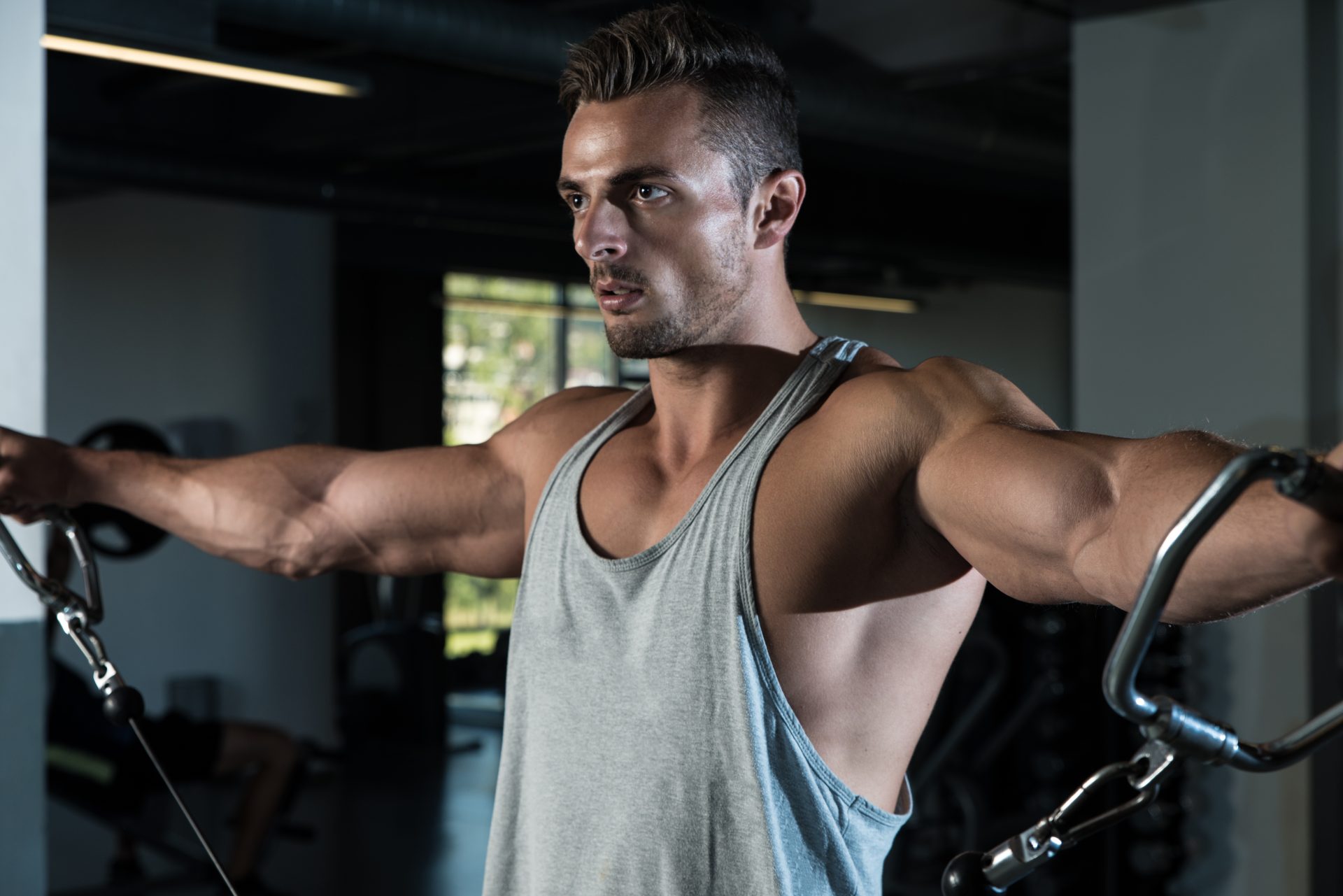Are you looking for a fantastic shoulder exercise to incorporate into your workout regimen? You have come to the right place.
Cable lateral raise is an excellent shoulder exercise focusing on the traps and strengthening the shoulder muscles. This exercise utilizes a cable pulley machine that produces constant tension on the targeted muscles. The primary targeted muscle of the lateral cable raise is the medial deltoid. This exercise helps produce strong shoulders and improves overall upper body stability. One arm cable lateral raise is one of the most effective variations of the original lateral raise.
This exercise is ideal for transforming round shoulders into a well-shredded and broad V-shaped look. Furthermore, the combination of frontal raise with lateral cable raise stimulates both the anterior and middle deltoid muscles.
This article discusses everything you should know about lateral cable raises— its benefits, muscles worked, alternatives, variations, and guidelines for performing this efficacious shoulder movement.
Let’s get started without any delay.
Contents
What muscles are worked on during lateral cable raise?
Here is a list of muscle groups that this exercise activates. By strengthening the following three deltoid heads, you can lift heavy loads and excel in weightlifting.
- Anterior deltoid
- Posterior deltoid
- Medial deltoid
How to perform a lateral cable raise with perfect form?
Follow the given instructions to perform lateral cable raises:
- Select a weight you can lift. Don’t overdo it because you will only use a single arm to lift it.
- Bend your knees while placing your feet shoulder-width apart.
- Grip the stirrup with your outside arm while fully extending your arms, keeping your back upright and your feet facing forward.
- For extra support, place your free hand on the machine.
- Slightly bend your elbow and raise the arm to reach shoulder level. Make sure to exhale when lifting.
- Do not rotate your elbow when lifting the stirrup; concentrate on the middle part of your shoulder.
- Stay in this position for 1-5 seconds, then slowly lower the weight. Also, inhale while letting the cable return to its original position.
- Do 10-15 reps of lateral cable raise for each set.
Lateral cable raises Variations:
Here are-sided lateral raise alternatives and variations to spice up your workout regimen and incorporate various movements for maximum output.
Two-arm cable lateral raise
If you find the traditional one-arm cable lateral raises too easy, step up by doing the two-arm cable lateral raise.
For this variation, you must stand between a cable crossover station and lift two pulleys simultaneously with each hand.
Follow the guidelines above to perform two-arm cable lateral raises without any injury.
Dumbbell lateral raise
For this variation, all you need is two dumbbells. There’s no requirement for a cable pulley machine.
To do this exercise, follow the given steps:
- Hold one dumbbell in each hand.
- Tighten your core and straighten your back by pulling your shoulders backward.
- Lift both your arms together until they are parallel to the ground. Pause for 1-5 seconds and slowly relax your arms into the starting position.
- Repeat the exercise for better results.
Elevator lateral raise
Once again, all this exercise demands is a pair of dumbbells.
However, the elevator lateral raise helps boost your resistance endurance and produces muscles faster than any other shoulder exercise.
Here’s a step-by-step guide for performing an elevator lateral raise:
- While standing up, set your feet shoulder-width apart. Hold one dumbbell in each hand and keep your back upright.
- Lift your arms to your shoulders. Do not bend the elbow.
- While bringing them down halfway, lift them to the top again.
- Slowly lower your arms fully and start again at the initial position.
Dead-stop lateral raise
This variation of the single-arm cable lateral raise eliminates and maximizes the tension produced in your muscles.
It is more effective when you include dumbbells instead of the cable pulley machine.
Here are the guidelines to follow when doing the dead-stop lateral raises.
- While sitting on a bench, hold q dumbbell in each hand.
- Extend out the dumbbells as the rest on the bench.
- Next, raise them until your arms are parallel to the ground.
- Take small pauses when lowering the dumbbell back to its original position.
- Repeat this exercise, and relax your grip after every rep.
Lateral cable raises benefits:
There is a never-ending list of cable raises variations. This wide variety has sparked a debate among gym-goers.
At the same time, some prefer dumbbell lateral raise, while others are true devotees to lateral cable raise.
Although both exercises are equally beneficial, the lateral cable raise focuses more on the medial deltoid, which enhances shoulder size and stability and tones the body.
Here is a list of the advantages of lateral cable raises:
Good posture
Cable lateral raise corrects the posture and strengthens all the muscles connected with the spine, including the back.
So if you spend all the time hunching over the desk or sitting with a lousy posture, then lateral cable raise is ideal for you.
Muscular shoulders
While many people at the gym may think frontal raises are the key to ripped and muscular shoulders, it’s not the case.
Cable lateral raise is a preferable option for bigger shoulders as it activates the medial deltoid.
This exercise also emphasizes the lateral deltoid muscle fibers that result in an athletic physique.
Correct muscular imbalances
Lack of activity and poor lifestyle habits diminishes muscle coordination, making you prone to injuries.
It is where lateral cable rise jumps in. This exercise fixes the upper body imbalances and introduces symmetry, stability, and mobility in the shoulder joint.
The bottom line
From the above discussion, we can summarize that lateral cable raise is an excellent shoulder-building exercise, which gives a balanced and athlete-looking shoulder shape.
Therefore, if you desire broader shoulders, add the lateral cable raise and its equally-effective variations to your daily workout regimen.
However, seek consultation from a professional trainer before starting any new workouts, especially if you suffer from underlying health complications or injuries.



